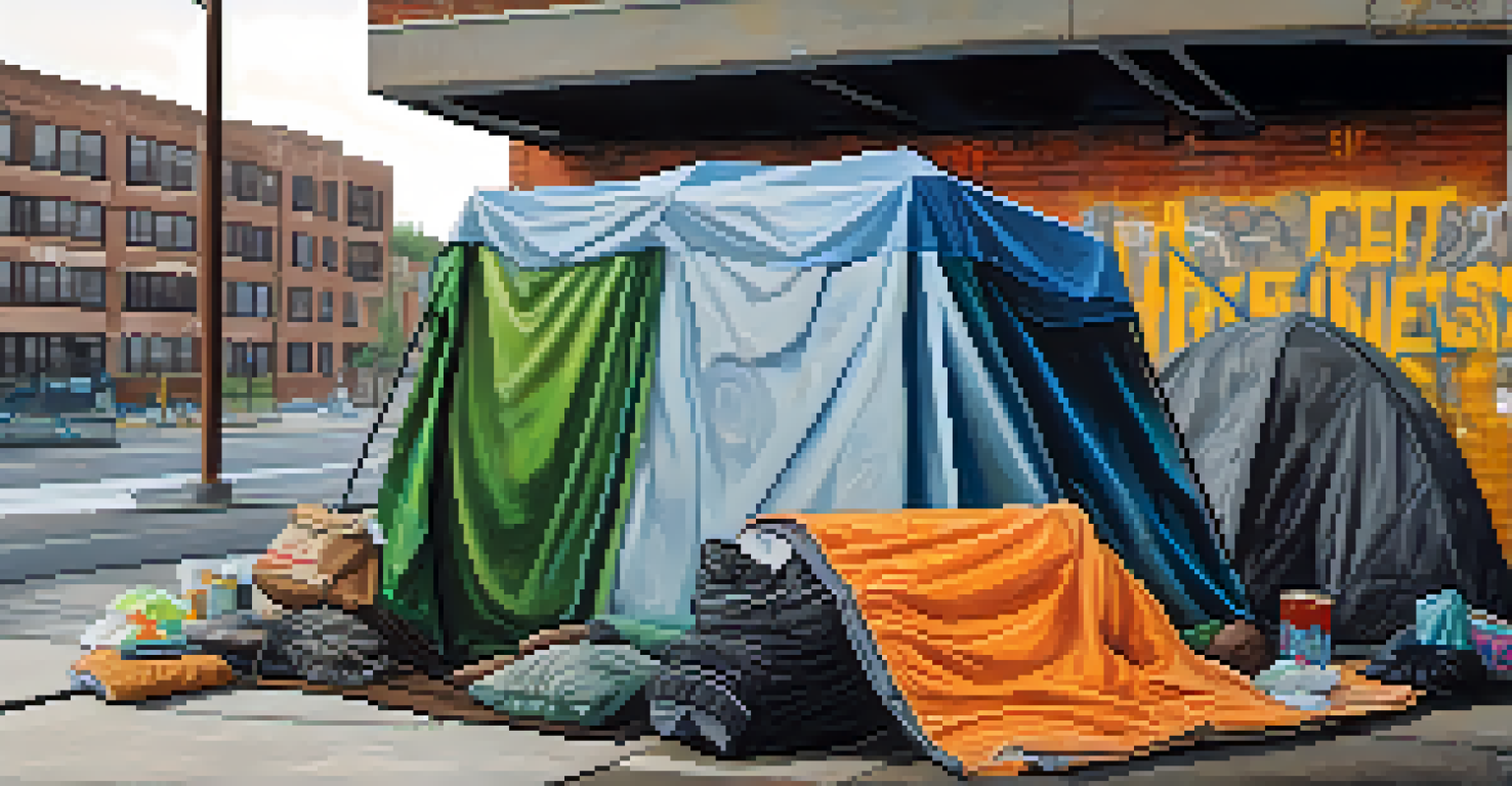COVID-19's Impact on NYC's Homeless Population

Overview of NYC's Homeless Population Before COVID-19
Before the pandemic, New York City had already been grappling with a significant homelessness crisis. Thousands of individuals found themselves living on the streets or in shelters, facing not just the harshness of their environment but also challenges like mental health issues and substance abuse. The city's complex social fabric, coupled with rising housing costs, made it difficult for many to secure stable housing. This backdrop set the stage for the unfolding crisis as COVID-19 began to spread.
The greatest challenge of the homeless is not the lack of a roof over their heads but the lack of a support system to help them overcome the barriers they face.
In 2019, the number of homeless individuals in NYC reached alarming levels, with over 60,000 people sheltered each night. These statistics highlight how systemic issues, such as economic disparity and insufficient affordable housing, have long plagued the city. The situation was dire, and support systems were already stretched thin, leaving many vulnerable. Little did anyone know that a global pandemic was about to exacerbate these existing challenges.
As the pandemic approached, advocates for the homeless were already warning about the potential fallout. They understood that a health crisis could disproportionately affect those living without stable housing. The lack of access to healthcare and the inability to follow safety protocols were looming threats that would soon become all too real.
Immediate Effects of COVID-19 on the Homeless Community
When COVID-19 hit New York City in early 2020, the effects on the homeless population were immediate and severe. Many individuals living on the streets were forced to confront the realities of a virus that thrived in crowded conditions. With shelters also facing restrictions, the options for safe refuge became even more limited. This left many feeling trapped and hopeless, exacerbating the already dire situation.

As fear of the virus spread, public spaces that previously provided some respite for the homeless, such as libraries and community centers, closed down. This loss of safe spaces further heightened the vulnerability of those living on the streets. Additionally, social distancing measures made it even more challenging to connect individuals with necessary services like food and healthcare. The community faced a perfect storm of challenges that made survival increasingly difficult.
Homelessness Crisis Pre-COVID
Before the pandemic, NYC faced a severe homelessness crisis, with over 60,000 people sheltered nightly amid rising housing costs and systemic issues.
Moreover, the psychological toll of the pandemic was profound. Many individuals experienced heightened anxiety and depression, exacerbated by isolation and uncertainty. The lack of social support and resources contributed to a sense of despair, making it crucial for support organizations to adapt quickly to changing needs.
Changes in Shelter Policies and Conditions
In response to the pandemic, NYC's shelter policies underwent significant changes aimed at protecting the health of residents. Many shelters implemented social distancing measures, reducing capacity to allow for more space between beds. While this was a necessary step, it also meant that fewer individuals could find shelter, leaving many without a safe place to stay. The challenge was to balance safety with the urgent need for shelter access.
In the face of crisis, community is not just a network of support; it is a lifeline that can transform despair into hope.
Additionally, new protocols were introduced, including health screenings and increased sanitation measures. While these changes were essential for health and safety, they also created a more formal and sometimes intimidating environment. Many individuals who were already wary of shelters due to past negative experiences found these new policies off-putting. This presented a dilemma for outreach workers trying to encourage vulnerable individuals to seek shelter.
As the pandemic continued, some shelters began to offer additional services, such as mental health support and case management. The goal was to address not just immediate safety concerns but also the underlying issues contributing to homelessness. However, the effectiveness of these programs varied, and many individuals still faced barriers to accessing help.
Government Response and Resources for the Homeless
In response to the growing crisis among the homeless population, local and state governments took measures to allocate resources and support. Emergency funds were directed toward shelters and outreach programs to help provide food, medical care, and mental health services. While these efforts were commendable, the scale of the issue often made it difficult to meet the overwhelming demand for help. Many organizations operated under limited resources, further complicating the situation.
One notable initiative was the conversion of hotels into temporary shelters, aimed at providing safer living conditions during the pandemic. This approach not only offered individuals a place to stay but also allowed for better health monitoring. While this was a step in the right direction, the transition was not without its challenges, including staffing shortages and the need for ongoing support services.
Pandemic Exacerbates Vulnerabilities
COVID-19 intensified the challenges for the homeless population, limiting access to safe spaces and essential services while increasing mental health issues.
Community organizations also played a pivotal role in bridging the gap. Many non-profits mobilized to provide essential services, from meal delivery to hygiene supplies. Their efforts highlighted the importance of community in navigating crises and showcased the resilience of both service providers and those they serve.
Impact on Health and Well-being of the Homeless
The health impacts of COVID-19 on the homeless population have been profound and multifaceted. Individuals experiencing homelessness already faced significant health disparities, and the pandemic only intensified these challenges. Many lacked access to regular healthcare, making it difficult to manage pre-existing conditions, leading to a higher risk of severe illness from COVID-19. This reality underscored the urgent need for accessible health services tailored to the homeless community.
Mental health issues also surged during the pandemic, as isolation and uncertainty took a toll on many individuals. Anxiety, depression, and substance abuse became more prevalent, complicating recovery efforts. The lack of consistent support systems made it challenging for individuals to find the resources they needed to cope. Community mental health initiatives became increasingly vital, offering a lifeline for many.
Furthermore, the stigma associated with homelessness often deterred individuals from seeking help, even when it was available. This cycle of shame and fear can create barriers that are hard to break. Addressing these health impacts requires a comprehensive approach that includes not just immediate care but also long-term support and understanding.
Role of Community Organizations and Volunteers
Community organizations and volunteers emerged as vital lifelines for the homeless population during the pandemic. They played an essential role in providing food, shelter, and medical care when government resources fell short. Many non-profits adapted quickly, shifting their operations to meet the needs of those most affected by COVID-19. This dedication showcased the power of compassion and community spirit in times of crisis.
Volunteers stepped up in unprecedented numbers, whether through delivering meals, distributing hygiene kits, or simply providing companionship. Their efforts not only filled immediate gaps but also fostered a sense of solidarity among those involved. These grassroots movements often created a network of support that made a significant difference in the lives of many individuals experiencing homelessness.
Need for Long-Term Solutions
As NYC recovers, addressing homelessness requires innovative and collaborative efforts focused on affordable housing and comprehensive support services.
However, the reliance on volunteers also highlighted the need for sustainable solutions. While volunteers can provide crucial support, the systemic issues surrounding homelessness require long-term strategies and investments. Advocates continue to call for greater government support and a more comprehensive approach to addressing the root causes of homelessness.
Looking Ahead: Future Challenges and Solutions
As New York City continues to recover from the pandemic, the challenges facing the homeless population remain daunting. With rising costs of living and the ongoing impacts of COVID-19, many individuals are still at risk of losing their housing. The city must prioritize affordable housing initiatives and support services to prevent an exacerbation of the homelessness crisis. Without proactive measures, the situation could spiral further out of control.
Innovative solutions are being explored, from permanent supportive housing to wrap-around services that address mental health and substance abuse. Collaborative efforts between government agencies, non-profits, and community members will be crucial in crafting effective strategies. These partnerships can create a more holistic approach to addressing homelessness, ensuring that individuals receive the comprehensive support they need to thrive.

Ultimately, the lessons learned from the pandemic can inform future strategies. The importance of adaptability, community involvement, and a focus on health and well-being will be vital as the city moves forward. By committing to long-term solutions, NYC can work toward a future where homelessness is not just managed but effectively reduced.